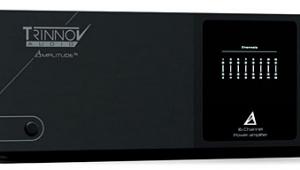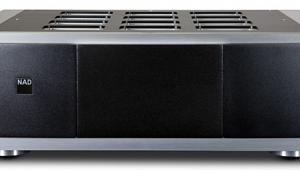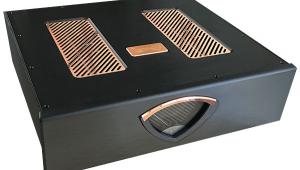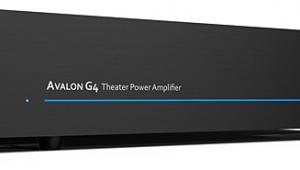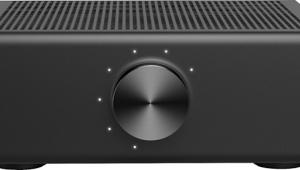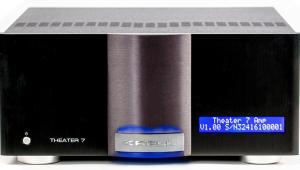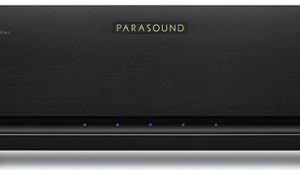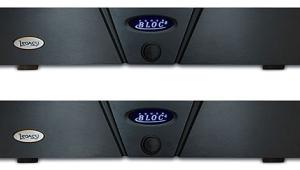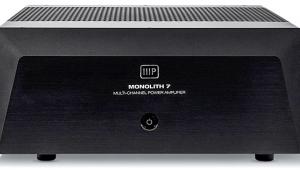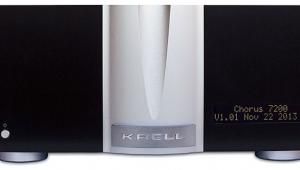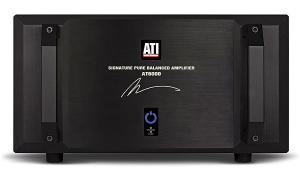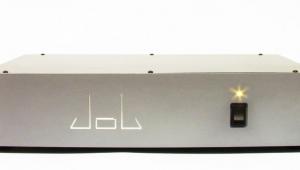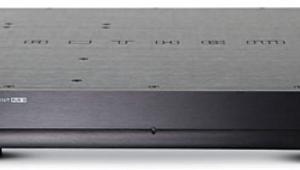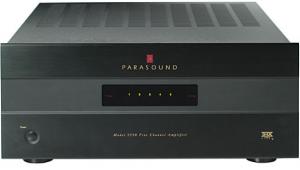Earthquake Cinénova Grande Seven-Channel Amplifier
Earthquake is not a bad moniker to have attached to an amplifier that can crank out some 300 watts across each of its seven channels. That kind of power, with the right speakers in front of it, can certainly set your listening room to rolling and rumbling. The name also applies well to the minor seismic event that will result when you drop this 122-pound behemoth into your equipment rack—assuming that you have an equipment rack that can hold it. But, as endearing as weight and power are in an amplifier, they don't tell the whole story of an amplifier's potential. Finesse and athleticism are just as important in a big, bulky amplifier as they are in a big, bulky linebacker.

A look inside Earthquake Audio's Cinénova Grande seven-channel model indicates that the team at Earthquake has gone to considerable lengths to prove that a potent combination of speed, grace, and power can be harnessed on a large, multichannel chassis. A good chunk of the Cinénova Grande's bulk is its massive 4KVA toroidal transformer, which tips the scales at more than 40 pounds. All seven channels share this transformer, but that's about all they share. In every other respect, the channels are independent monoblocks, right down to the fact that you can remove and service each as a separate module. Each channel has its own power supply and preamplification stage and possesses no less than 20 15-gigahertz output transistors, which helps to account for the speed this thing has.
Each block also has a substantial amount of heatsinking and protection with individual thermal sensors, in addition to peak LED indicators on the back panel and a pair of 10-amp fuses on the power-supply rails. The individual rear panels supply a single-ended (RCA) and a balanced (XLR) input, five-way binding posts, controls for an independent filter with options for high-pass, low-pass, or bypass operation, and a crossover range from 20 hertz to 5 kilohertz. A pre/pro normally handles the filtering, but this is an interesting feature. I set up the Cinénova Grande with a variety of playmates—some priced below its level, and some priced above—which gave it the opportunity to prove itself across a broad range of price categories. The speakers included a couple of excellent systems from Energy and B&W. For pre/pros, I went with the Lexicon MC-12 and the Parasound C2. The same diversity of price and strength of performance applied to the source units, as well, with the Marantz DV8300 and the Simaudio MOON Orbiter universal players.
It was hardly surprising that the Cinénova Grande kicked away from the gate with a truly impressive display of raw power. I set it to work immediately in two-channel mode with a diverse array of cage-rattlers, playing everything from Beethoven's Fifth, to the pipe-organ assault of Lindenkirche Berlin (Burmester Vol. 2), right through the 30-instrument barn dance of "Katy Hill" (The Three Pickers, Rounder Records). The Cinénova Grande met these challenges with a massive, wide-open soundstage, and it refused to constrict even the smallest of nuances anywhere in the presentation. Having seen the corresponding concert of The Three Pickers several times, I know where everyone is supposed to be and, thus, knew right away that the amplifier was reproducing the stage immaculately. Visual aids were hardly necessary to lay the soundfield out properly in my mind—that's how good a job this amplifier does of reproducing distinct events, even in a crowded, hard-driving context.
All of this power was laced with acumen and dexterity. As good as the Energy Veritas 2.4 speakers are, they are most successful with an amp that can drive their occasionally laid-back midbass through with authority but can also keep a handle on their sometimes-exuberant top end. You can't just throw raw power at these speakers and expect them to perform their best. The Cinénova Grande did a highly successful job of addressing both of these aspects, resulting in a near-perfect tonal balance from top to bottom, with no hints of editorializing or overmanipulation.
You'd expect impressive dynamic range from an amp with this kind of résumé, but you'd probably still be surprised by what it does with high-resolution material, opening the window even further. I hit it with symphony after symphony and found myself constantly noting how well this amp preserves soft, subtle nuances, like dancing piccolos. But it also gives large, powerful events, like brass and percussion barrages, incredible authority and excitement. I decided to use the in-the-orchestra perspective to really see what this amp could do with all of the channels blazing. In turn, one of this amp's most memorable displays of power, agility, dynamic range, and everything else came with a playing of Respighi's Pines of Rome (AIX Records). You haven't entirely heard the magnificent climax that defines this piece until you've put yourself in the middle of it. It may not be the textbook way to listen, but it will blow you away—especially with a combination like the Cinénova Grande and B&W speakers exploiting every last element of the frequency range with off-the-chart dynamics, raw power, and a free-flowing sense of ease and composure.
The Respighi experience put me in the mood for a more active surround field, so I tried out some war movies like Saving Private Ryan and Band of Brothers, as well as big adventure films like the Lord of the Rings trilogy—none of which cheat you on surround effects. Thankfully, both the Veritas 2.4s and the B&Ws are the kind of surround speakers that can make good use of their massive wattage allotment. It would be a shame to put undersized surrounds with this amp. I ultimately used the Energy and B&W speakers in a seven-channel array that about blew the door off the room, but not in a way that was uncomfortable or overly aggressive. Undoubtedly due, in part, to all of its extra headroom, this amp possesses that rare ability to tear through the densest, most complicated material with incredible punch, power, and control, without ever dropping hints that it's having to work very hard to do so. There were none of the sonic indications, like dynamic compression or fatigue, or even the physical signs, like excessive heat. The experience of using this amp is not unlike driving a high-end luxury sedan where the engine is purring along, barely breaking a sweat at 3,000 RPMs, and only when you look at the speedometer do you realize you're going 120 miles per hour.
Power is the lifeblood of a home theater system, and you don't have to know much about it to know this: You want it to be clean, you want it to be true, and you want a lot of it. Finding all of this in one package isn't cheap or easy, and that's why true high-end amplifiers like the Cinénova Grande cost what they do. If you don't give power its due when you build your system, it's easy to end up with either a whole bunch of hapless, distorted watts or an amplifier that sounds good at modest volumes but not much else. Power with composure and athleticism, such as that which the Cinénova Grande presents, is a rare thing, and it's worth paying extra for. Everybody remembers a good earthquake, and the Cinénova Grande is no exception.
Highlights
• Power to burn
• Modular, monoblock configuration
• Balanced inputs
- Log in or register to post comments
